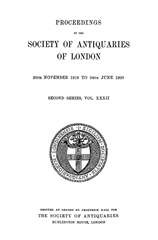No CrossRef data available.
Article contents
Thursday, January 26th, 1899
Published online by Cambridge University Press: 10 May 2010
Abstract

- Type
- Proceedings
- Information
- Copyright
- Copyright © The Society of Antiquaries of London 1899
References
page 295 note * The altar is now in Tullie House, Carlisle, having been purchased from the rector and churchwardens of Bewcastle under the authority of a faculty from the Consistory Court of Carlisle.
page 297 note * The Bill of the Graces, 1897.
page 297 note † El-Asnam mta el-Jahilieh, i.e. Idols of the pre-Islamic or Pagan age.
page 297 note ‡ This belief as to their origin is widely spread. See a passage in D. Brunn's Cave Dwellers of Southern Tunisia, translation, 1898, p. 95, which seems to imply that it is even known 150 miles from Tarhuna in South Tunis.
page 298 note * It is impossible to go here into detail. Sir L. Playfair has estimated that all Algeria could grow 100,000,000 olive trees (i.e. one tree per acre), meaning doubtless that all other crops should have their due area of land surface. Near Jerusalem there are thirty to forty trees per acre, but since only one acre in each hnndred is under olives, this really means about one tree to three acres. The point is that in Tarhuna, as in Syria and Algeria, other crops and cattle must have claimed their share of land surface, especially as there were the big towns on the coast to feed. Besides, the country is so broken with wadies that there is, much waste.
page 299 note * But at the Syrian rate of only 40 trees to 100 acres, 53 “Senam ” presses would suffice.
page 289 note † i.e. the Senams proper like trilithons.
page 300 note * Such may well have cropped up again in a few centuries. But if the Arabs themselves used the oil-presses as idols (as suggested by Messrs. Myres and Evans) they certainly would not call them by the term Jahilieh (![]() ) which is specially used for the pre-Mohammedan and pagan period.
) which is specially used for the pre-Mohammedan and pagan period.


